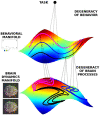Degeneracy and Complexity in Neuro-Behavioral Correlates of Team Coordination
- PMID: 33132866
- PMCID: PMC7513679
- DOI: 10.3389/fnhum.2020.00328
Degeneracy and Complexity in Neuro-Behavioral Correlates of Team Coordination
Abstract
Team coordination-members of a group acting together rather than performing specific actions individually-is essential for success in many real-world tasks such as military missions, sports, workplace, or school interactions. However, team coordination is highly variable, which is one reason why its underlying neural processes are largely unknown. Here we used dual electroencephalography (EEG) in dyads to study the neurobehavioral dynamics of team coordination in an ecologically valid task that places intensive demands on joint performance. We present a novel conceptual framework to interpret neurobehavioral variability in terms of degeneracy, a fundamental property of complex biological systems said to enhance flexibility and robustness. We characterize degeneracy conceptually in terms of a manifold representing the geometric locus of the dynamics in the high dimensional state-space of neurobehavioral signals. The geometry and dimensionality of the manifold are determined by task constraints and team coordination requirements which restrict the manifold to trajectories that are conducive to successful task performance. Our results indicate that team coordination is associated with dimensionality reduction of the manifold as evident in increased inter-brain phase coherence of beta and gamma rhythms during critical phases of task performance where subjects exchange information. Team coordination was also found to affect the shape of the manifold manifested as a symmetry breaking of centro-parietal wavelet power patterns across subjects in trials with high team coordination. These results open a conceptual and empirical path to identifying the mechanisms underlying team performance in complex tasks.
Keywords: coherence; degeneracy; hyperscanning; manifold; social coordination; symmetry breaking; team work; wavelets.
Copyright © 2020 Dodel, Tognoli and Kelso.
Figures




Similar articles
-
Are Neurodynamic Organizations A Fundamental Property of Teamwork?Front Psychol. 2017 May 2;8:644. doi: 10.3389/fpsyg.2017.00644. eCollection 2017. Front Psychol. 2017. PMID: 28512438 Free PMC article.
-
Functional dissociation of brain rhythms in social coordination.Clin Neurophysiol. 2012 Sep;123(9):1789-97. doi: 10.1016/j.clinph.2012.02.065. Epub 2012 Mar 17. Clin Neurophysiol. 2012. PMID: 22425484
-
Recording human electrocorticographic (ECoG) signals for neuroscientific research and real-time functional cortical mapping.J Vis Exp. 2012 Jun 26;(64):3993. doi: 10.3791/3993. J Vis Exp. 2012. PMID: 22782131 Free PMC article.
-
Prospects for Augmenting Team Interactions with Real-Time Coordination-Based Measures in Human-Autonomy Teams.Top Cogn Sci. 2024 Jul;16(3):391-429. doi: 10.1111/tops.12606. Epub 2022 Mar 9. Top Cogn Sci. 2024. PMID: 35261211 Review.
-
Neurobiological degeneracy: A key property for functional adaptations of perception and action to constraints.Neurosci Biobehav Rev. 2016 Oct;69:159-65. doi: 10.1016/j.neubiorev.2016.08.006. Epub 2016 Aug 6. Neurosci Biobehav Rev. 2016. PMID: 27506266 Review.
Cited by
-
The degenerate coding of psychometric profiles through functional connectivity archetypes.Front Hum Neurosci. 2024 Sep 10;18:1455776. doi: 10.3389/fnhum.2024.1455776. eCollection 2024. Front Hum Neurosci. 2024. PMID: 39318702 Free PMC article.
-
Guardiola, Klopp, and Pochettino: The Purveyors of What? The Use of Passing Network Analysis to Identify and Compare Coaching Styles in Professional Football.Front Sports Act Living. 2021 Oct 22;3:725554. doi: 10.3389/fspor.2021.725554. eCollection 2021. Front Sports Act Living. 2021. PMID: 34746774 Free PMC article.
-
Human turn-taking development: A multi-faceted review of turn-taking comprehension and production in the first years of life.Psychon Bull Rev. 2025 Aug 7. doi: 10.3758/s13423-025-02749-8. Online ahead of print. Psychon Bull Rev. 2025. PMID: 40775587 Review.
-
Coordination Dynamics: A Foundation for Understanding Social Behavior.Front Hum Neurosci. 2020 Aug 14;14:317. doi: 10.3389/fnhum.2020.00317. eCollection 2020. Front Hum Neurosci. 2020. PMID: 32922277 Free PMC article.
References
Grants and funding
LinkOut - more resources
Full Text Sources

